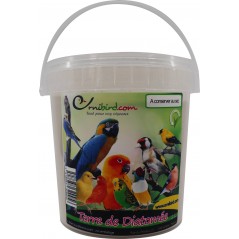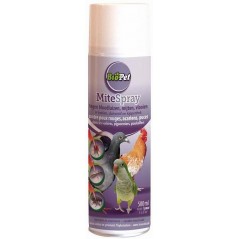

Ornibird.com, le spécialiste pour vos Oiseaux et Animaux !
Ornibird.com, le spécialiste pour vos Oiseaux et Animaux !


(€37.87 kg)



It was the unanimous opinion of the farmers, the pou red (Dermanyssus gallinae) is now the external parasite the more harmful of the aviaries, dovecotes and poultry houses. Whether it's birds ornaments, small flocks of enthusiastic amateurs or farming professionals, hens, pheasants or quail, it is very rare not to have been contaminated by this parasite.
It is considered that 70 to 80 % of breeding farms and professionals of laying hens are affected more or less severely. The result is a greatly reduced egg-laying, and even death by exhaustion of hens in the most serious cases.
Unfortunately, no bird is ever completely immune to the head lice red. They may be introduced into the cage, the aviary or the chicken coop by a newcomer, by a new object, and even... by the breeder himself. The pou red may stay temporarily on the man and even on other mammals such as the rat or the dog ! However, it would appear that this parasite is rarely caused by wild birds (for example by a nest of sparrows or pigeons nearby), and because studies of the ITAVI (Sophie Lubac, one of the great specialists in France) have highlighted that the strains are different.
The bird breeders enthusiasts (hens, pigeons, canaries, parakeets...) also meet very often with this parasite. And it is very difficult to get rid of it. The pou red is a mite of 0.5 mm to 1 mm long qualified ectoparasite intermittent, which means that it does not live permanently on its host and it does the "visit" to feed. Lice red shuttle up to 8 to 10 times per day between their refuge (any crevice possible, space between two plates, crack in the wood, the air gap between two plates, to an angle of the building, etc.) and his victim. They will remain as one to two hours on the bird to get their fill of blood, which will increase their color from gray to bright red and later to dark red almost black when the digestion is complete. The nuisance of head lice red don't stop there : it is now established that the bites transmit many diseases through the blood... and even when an aviary or a chicken coop hit by an epidemic emptied and cleaned, it is sufficient that head lice red emerge out of their hiding place after the introduction of new birds, for they are contaminated by the germs of birds which have gone before !
The pou red reproduces very quickly : a female can lay 100 to 200 eggs per week, and the complete cycle (egg to egg, then to its birth and up to adulthood reproductive health) may not exceed one week under conditions of temperature and moisture favorable. In addition to this, it is also exceptionally tough : if the temperature and the hygrometry (humidity) come to fall, or when the food runs out, the red louse can "hibernate" for up to 8 months without feeding. They are even able to survive by taking the protein needed in the droppings, feathers and dust.
The table is nearly complete : the enemy is formidable, it will have to arm themselves with courage and patience !
Then, it is likely that your farm is infested.
But to be sure, do this simple test:
Hang a piece of paper towel or a cloth in white ball close to the birds... wait a few days and unfold. If there are parasites in your livestock, they will be installed in priority in the folds.
But nothing is lost... some of the rules of prevention can help avoid this scourge, and treat it where it is, unfortunately, afflicted. The following tips will help you make the point, and build your battle plan !
Our mineral powders Bi-Lice® trap moisture and regulate the pH without harming the birds or breeders. They do not contain insecticides, neurotoxic. Their effectiveness is therefore constant in time.
They dry out the environment . Our tests performed in the laboratory clearly show... What are the mineral powders the most effective currently available. They have been the subject of several international patents.
Their effectiveness will depend on the quality of their application and the cleanliness of the media. Regardless of the treatment product, it is important to know that dust, feathers and droppings are the allies of parasites and bacteria... surfaces must therefore be the cleanest possible.
Here's what you need to do as soon as you have received your Bi-Lice®:
It is necessary to leave a situation as healthy as possible: empty entirely the cage, the aviary or the chicken coop, dispose carefully of the straw or litter (the ideal being to burn if that is possible). Remove all the dust and please do not hesitate to wash it with water with liquid soap (the black soap - also available on this site - is very effective).
On the horizontal surfaces and in the nests : apply the product as a powder, spreading as evenly as possible. You can use a sieve to surfaces the short-range, and a powdery mechanics for large aviaries or large houses. If you are using newspaper, apply the powder UNDER and OVER the log. If you use straw, litter, or sand, sprinkle well above. It is not necessary to use large quantities of Bi-Lice®, but to spread it as evenly as possible.
On vertical surfaces, walls, items, cages, etc...): make a solution by mixing 200 grams of powder to 1 litre of warm water (it is important to obtain after mixing a fluid consistency and without lumps), and then spray on all surfaces in a light veil uniform (the product should, if possible, do not run after application). Stress in the cracks and corners. The product becomes active after drying.
A regular monitoring will then be provided to make a new application of powder in the shortest possible time, if you notice again the presence of lice, red (remember to use the tip of the paper or the cloth white).
To protect your livestock from moisture and to regulate its pH, a systematic application of powder every time you clean your aviary or your chicken coop gives excellent results. Because the Bi-Lice® is safe and non-toxic, its use is without risk of poisoning to your bird and for you. The powder remains effective as long as it is not covered with a layer of dust.
An alternative safe and effective.
Many testimonies of breeders of small birds (canaries, parakeets, etc.) or bigger birds (pigeons, chickens, pheasants, and other fowl) on blogs and forums breeders attest to the effectiveness of the product.
It is the only product of its type "bicarbonate+silica" regularly used by the professionals of the poultry. More than 10 million egg-laying hens have already benefited from the improvement of their hygiene conditions in this way.
The Bi-Lice® combines the properties of sodium bicarbonate, of which the safety is long established and a very quality specific precipitated silica, amorphous (totally free of crystalline silica)
These components do not present any danger for man or the animals in case of accidental ingestion, and no risk of silicosis, in normal conditions of use.
The Bi-Lice® can be applied directly into the nest to protect the chicks of their écolosion. It fully preserves the reproductive potential of birds contest.
Bi-Lice® is not a preparation which is classified as 'hazardous' according to Directive 1999/45/EC. Its composition has been recorded on August 8, 2006 by the INRS (National Institute for Research and Safety) under no 93281.
However, as in the use of all the powders, we recommend that you protect the eyes with safety goggles and wear a dust mask.
Bi-Lice® is a " usable Product in Organic Agriculture in application of RCE n° 834/2007 " and certified by Ecocert (in the version in bags of 20 kg under the name Bi-Protec®), the Bi-Lice® is perfectly suitable for use in farms as organic.
In addition, your eggs can be eaten without restriction even immediately after application of the Bi-Lice® in your pens or your chicken coops. You will not take any risk for your birds and for you.
Data sheet
Specific References
No customer reviews for the moment.


(€37.87 kg)
check_circle
check_circle










